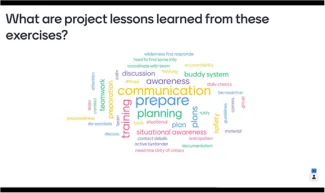Participants across the NGEE Arctic team participated in Table Top exercises for increasing awareness and encouraging improved safety responsiveness to potentially dangerous field work scenarios.
The NGEE Arctic project is a rich and diverse mix of national laboratory and university scientists, faculty, and early career researchers all working to better understand the fate of tundra ecosystems in a rapidly changing world. A major component of this project focuses on field research that requires frequent travel to remote areas of Alaska far removed from our normal support network often provided by family and friends. It is amidst this diverse and dynamic environment that project members find themselves in unfamiliar places working alongside people from equally diverse backgrounds and life experiences. The exercises were intended to start respectful conversations and exchange of ideas among the team, and to answer the question “What would you do?” under specific and targeted events that the team envisioned could happen to anyone during the course of normal NGEE Arctic field work in remote areas of Alaska. Thus, the NGEE Arctic team gathered together virtually over the course of two days in late August 2021 to discuss these real-life scenarios, raise situational awareness, and assess their level of preparedness during a series of Table Top exercises patterned after those held by FEMA. Approximately 30 NGEE Arctic team members participated on each day, and rotated through a series of five breakout rooms led by project facilitators on Arctic-specific scenarios ranging from: a serious car accident, to a suspected COVID-19 illness, to an encounter with a visitor in the field, to sexual/verbal assault, to a negative wildlife encounter. Responses from participants indicated that the initial event was a success, and each breakout session was able to provide feedback on the needed pre-planning for each scenario, the consensus scenario response(s), and topics for further project consideration. These conversations and lessons learned will be included in our project safety manual and this event has served as an excellent example of safety planning for at least one local institution. Our team has made a commitment to hold these exercises on a semi-regular basis, such as during our annual All-Hands Meeting or before the field season begins each spring.


